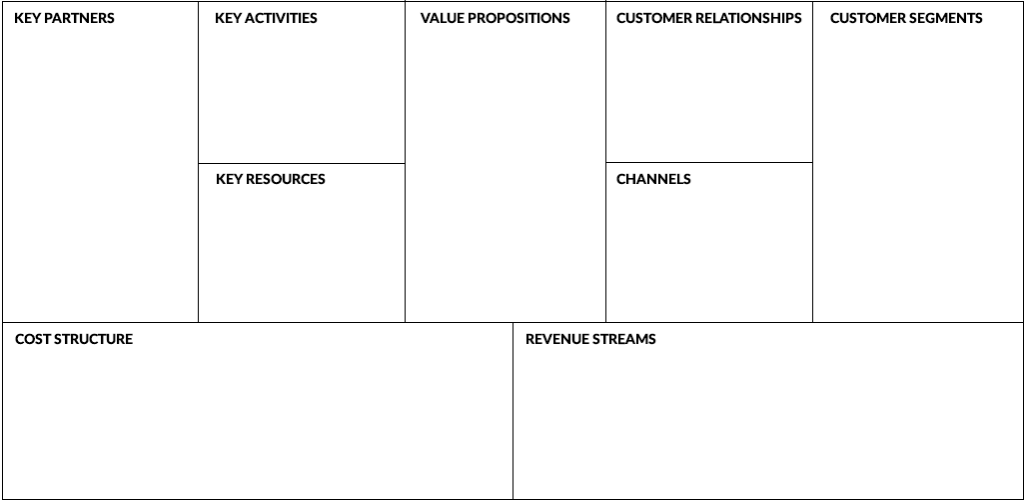Tips for Quickly Writing a Business Model Canvas For Your Ecommerce Store

When most people launch a business, they usually start by writing a business plan. The business plan outlines every detail, from the products sold, to the competition, to the marketing ideas, to the sales projections. However, business plans are very time consuming and are often outdated by the grand opening, thanks to the fast-paced nature of business. Instead, we recommend writing a business model canvas, a condensed (and much simpler) version of the standard business plan. BMCs are a one-page snapshot of your business and can usually be written in just 30 minutes. Most business model canvases include:
- Value Propositions
- Customer Segments
- Customer Relationships
- Channels
- Key Resources
- Key Activities
- Key Partners
- Cost Structures
- Revenue Streams
Know Your Value Before Starting Your Business Model Canvas
- What’s Your Purpose: We don’t mean to get all existential on you, but to begin writing your canvas, you need to know the “why” of your business. Why are you taking this venture on? Do you want to be self-employed? Do you want to help others? Are you hoping to provide employment to others? Do you just want to do something with your spare time? Having a clear purpose will help you to fill out the rest of the BMC.
- Value Proposition: Once you’ve definitively stated the purpose of your business, the next step is to outline the value you’re providing to your customers. The more unique your value, the more likely your business is to do well (because you’ll be filling an untapped market). You can have more than one value proposition, which also increases your likelihood of success.
Know Your Customer
- Customer Segments: Before you can start selling to your customers, you need to know who they are. This knowledge will influence where you sell, how you market, and what you charge for your product. Ask yourself what gender your average customer is, how old they are, their income level, what work they do, their goals and beliefs in life, and more. Build a complete personality for your customer, as if you were going to be able to walk to the nearest coffee shop and have a chat with them. Many businesses often appeal to more than one customer segment so build as many consumer profiles as you think will apply.
- Customer Relationships: Once you know who your customers are, you can start planning what your typical relationship with them will be. Will your customers buy from you once and never need another of your products again? Or will they buy time and time again? Are your customers loyal to brands or do they buy from the most convenient source? Do you want to build a small, but dedicated following or would you rather concentrate your efforts on constantly bringing in new customers? There are dozens of relationships brands have with their customers and the more you understand yours, the better you’ll understand your business as whole.
- Channels: Finally, you need to consider how you’re going to reach your customers. Advertising your pet store on Twitter to reach grandmothers who want to buy toys for their cats probably isn’t the best move. BUT, advertising your travel agency on Twitter to millennials who want affordable vacations might be the perfect channel in that circumstance. There are dozens of ways to reach out to your customers, including through broadcast, print, and social media.
Know Your “Keys”

- Key Resources: This section on your business model canvas will just be a point form list of physical and otherwise assets your business will require to operate. Resources may include employees, storefronts if you have them, supplies and tools, etc.
- Key Activities: Another easy, point form list, key activities refers to the most crucial elements of the work you do to sell your product. This might include making the product itself, packing goods to ship, making sales calls, writing a related blog, and more.
- Key Partners: Your key partners section is a list of all the people who work outside your business that allow it to operate smoothly. Partners could be suppliers, merchants who stock your product, and sponsors who promote your business.
Know Your Finances
- Cost Structures: Many people shy away from filling out cost structures because all of a sudden numbers and math are involved. However, the cost structures section of your business model canvas only needs to be a basic list of your top five or so highest operating expenses. That might be supplies, shipping costs, rent, wages, advertising, etc. Optionally, you can include how much you spend on each item and how often you spend it.
- Revenue Streams: On the flip side of cost structures, revenue streams detail where and how income comes from. You might receive income from individual customers at storefronts, customers on your website, or businesses who buy in bulk. Extra detail can also be added like how much each customer segment spends on average in a single transaction, and how they pay (through cards, PayPal, cash, etc.).
Business model canvasses aren’t as detailed as business plans but they’re great for quick references and can be updated in a matter of minutes, as often as you see fit.
Visit Shopivo and stay tuned for exciting news and updates! Sign up for our emails and stay up-to-date on new developments and features.
